12 Health Benefits of Anjaneyasana & How to Do It?
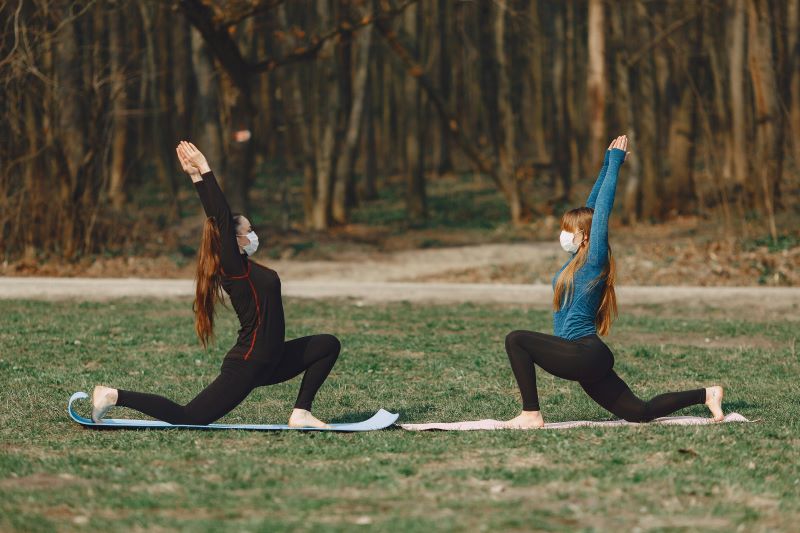
There are many postures suggested by yoga practitioners that lower the level of cortisol and relieve anxiety symptoms. One of the most effective ones to mention is Anjaneyasana, or Low Lunge.
To learn more about the benefits of Anjaneyasana, how to perform it, and other details, read this piece until the end!

Table of Contents

What is Anjaneyasana?
Low Lunge Pose, or Anjaneyasana, is named after the mother of the Hindu God Hanuman, ‘Ajani’, also called ‘Anjaneya.’ In the Hindu religion, Hanuman is a deity that brings courage, strength, dedication, valour, and power, just like those who practise low lunges.
Performing this exercise stretches the tight muscles in your lower body and gives you access to a fuller range of motion. Thus, it is perfect for those with desk jobs or athletes. However, people also practise it to feel relaxed or to build greater strength, flexibility and balance.
How to Perform Anjaneyasana (Low Lunge Pose)?
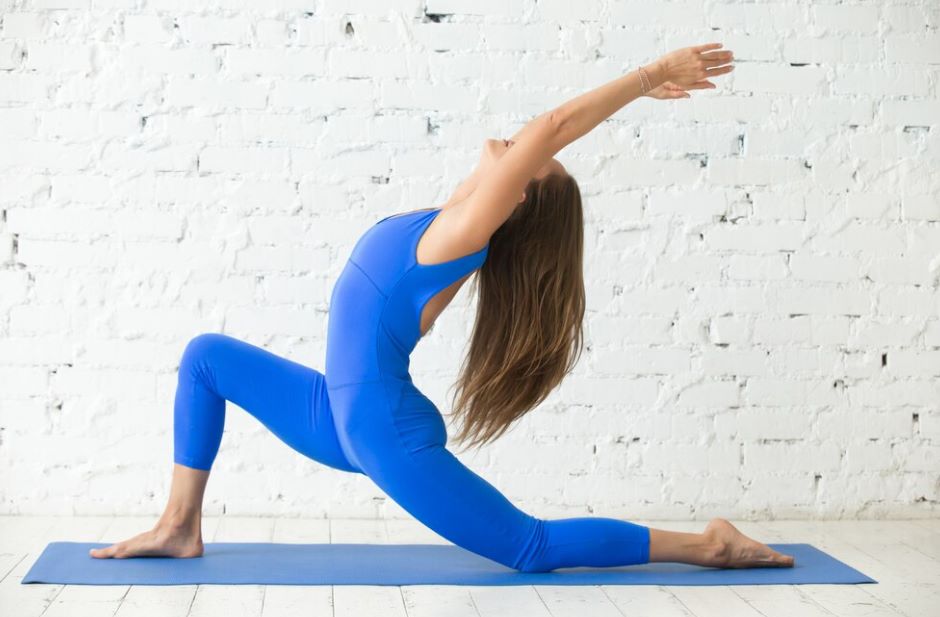
It may seem easy to perform Anjaneyasana, but maintaining the position for a long time is challenging. However, with regular practice and effort, you can master it. Here are the steps to perform it in the right way:
Step 1: Start by standing tall on a mat.
Step 2: Take a wide stance and separate your legs apart. Place your hands on your hips.
Step 3: Turn your right toe 90 degrees outwards and rotate your upper half to the right.
Step 4: Bend the knee and pull up the back of your heel above the ground.
Step 5: Lower your left knee while you exhale and rest the lower leg with your toes pointing back.
Step 6: Slowly breathe while you raise your arms and join the palms above your head.
Step 7: Lean back as much as possible. Balance this posture for 5 to 8 breaths.
Step 8: Inhale and come back to the normal position.
Step 9: Curl the toes of your back foot and try to straighten up your legs.
Step 10: Turn forward and repeat the same process for the other side.
Step 11: Bring your legs together and relax in the standing asana.
12 Health Benefits of Anjaneyasana
Anjaneyasana is a foundational yoga posture that offers a multitude of health benefits. The following are some top benefits you can experience by adopting low lunges in your daily life:
1. Builds Awareness and Mental Focus
One of the most significant advantages of Anjaneyasana is that it benefits your health and affects your brain to improve focus and awareness. The pose improves concentration, enhances mental strength, helps you be present in the current moment, and forms a stronger mind-body connection.
2. Relieves Sciatica and Other Spinal Conditions
Spinal conditions like sciatica have become familiar with a sedentary lifestyle, and performing low lunges regularly helps avoid that. The therapeutic effect of this yoga asana relieves you from the excruciating pain of sciatica. Moreover, bending makes your spine strong and mobile, preventing conditions.
3. Enhances Lower Body Strength and Flexibility
While performing low lunges, you engage your thighs, hips, groyne, quadriceps and hamstrings. This provides you with better motion and flexibility while increasing your stress level, increasing circulation and preventing injury.
4. Balances Chakra
Low Lunge Poses act both as a hip opener and a chest opener, stimulating the chakra and balancing it. By practising low lunge, your heart chakra opens up, which is the centre of universal love and self-love, thus bringing you care and compassion. Apart from this, it is seen that people carry negative emotions around the hips, and when the hips open up, they release feelings.
In addition, it stretches your pelvis and groin, stimulating your sacral chakra and enhancing creativity. An abdominal stretch activates the Manipura chakra, which balances emotions. Lastly, the slight neck stretch activates your throat chakra, which brings clarity to communication.
5. Decreases Stress and Anxiety
If you deal with mental problems like stress and anxiety, then low lunges can significantly help. We have tightness around the hips due to building up emotions, and when they open, so do the stress and anxiety. As a result, you feel more grounded, stable and upright.
In addition, the pose helps you calm down, look into your heart space and focus on your breathing. You teach yourself patience and perseverance by holding this posture for a few breaths.
6. Improves Abdominal System
Lung pose is highly beneficial for your abdominal area, enhancing its function by inducing weight loss effects, improving digestion and toning your abdominal muscle. Yoga enhances fertility, improves the reproductive system, and removes menstrual discomfort.
7. Re-Energises the Body
This one comes under the hidden pros of Anjaneyasana, but the pose also helps re-energise your body. The pose stretches out the lower portion of your body, thus increasing blood flow throughout the body. This further prepares you to take up more challenging postures.
On the other hand, the front body stretch awakens you emotionally and physically. This also means you can perform this exercise any time of the day as it provides energy without overstimulating your nervous system.
8. Improves Metabolic Functions
The pose also provides a great stretch to your neck muscles and thyroid region. As a result, it activates the gland's proper functioning and boosts the body's metabolic functioning.
9. Opens the Chest Muscles
This pose encourages an open chest and expanded lungs, improving respiratory function and overall lung capacity. As the chest opens, it facilitates deeper breathing, enhancing oxygen intake and distribution throughout the body. This improved respiratory efficiency can support better athletic performance and overall vitality.
10. Relieves Menstrual Discomfort
Gentle stretching and pelvic opening in Anjaneyasana can help alleviate menstrual cramps and discomfort. The pose increases blood flow to the pelvic region, reducing pain and tension associated with menstruation. Practising this asana regularly can provide relief and promote reproductive health.
11. Encourages Mind-Body Connection
Anjaneyasana fosters a deeper connection between the mind and body through coordinated movement and breath. This heightened awareness can lead to better self-understanding and mindfulness, promoting overall well-being. The pose can be a powerful tool for developing a more holistic approach to health and wellness.
12. Enhances Mental Focus
Holding Anjaneyasana requires concentration and mindfulness, which can improve mental clarity and focus. The need to balance and breathe deeply while in the pose helps to sharpen cognitive function and enhance mental discipline. This improved focus can carry over into daily tasks and activities.
Other Benefits:
Improves blood circulation
Help cope with cold temperatures by producing heat
Enhances the reproductive system and its function
The Mudra of Anjaneyasana (Low Lunge Pose)
Anjaneyasana, or the Low Lunge Pose, can be enriched by incorporating mudra or hand gestures, which enhance the pose's physical and mental benefits. You can incorporate a single mudra in Anjaneyasana, which is:
1. Anjali Mudra
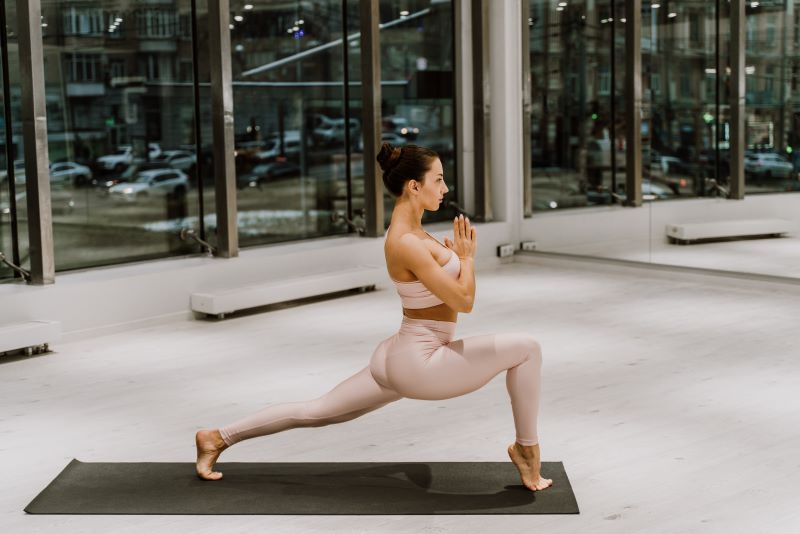
Start in the Low Lunge Pose with one foot forward and your back knee on the ground. Press your palms together in front of your heart in a prayer pose. Keep your shoulders relaxed and your spine straight. This mudra fosters a sense of balance and gratitude.
Benefits of Anjali Mudra: Including Anjali Mudra helps calm the mind and promotes inner peace, enhancing the meditative quality of Anjaneyasana. It also aids in balancing the body and focusing the mind.
2. Tadasana Mudra
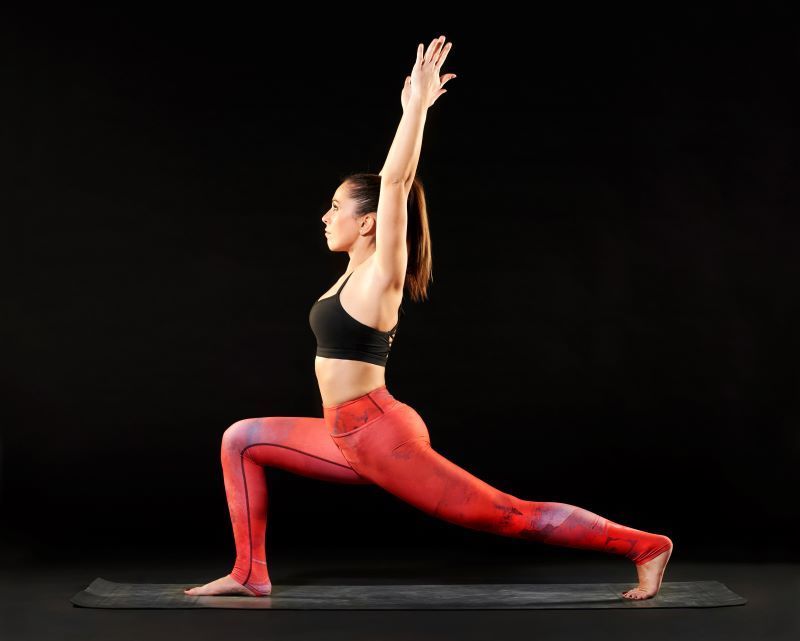
This mudra helps ground your energy and promotes stability. With your arms raised overhead in Anjaneyasana, lengthen your fingertips towards the ceiling, keeping your palms facing each other.
Benefits of Tadasana Mudra: Improves stability and grounds your energy while holding Anjaneyasana, similar to feeling rooted like a mountain.
Types of Anjaneyasana
Anjaneyasana, or the Low Lunge Pose, has several variations that target different areas of the body and offer unique benefits. Here are some common types of Anjaneyasana:
1. Anjaneyasana Hands to Knee
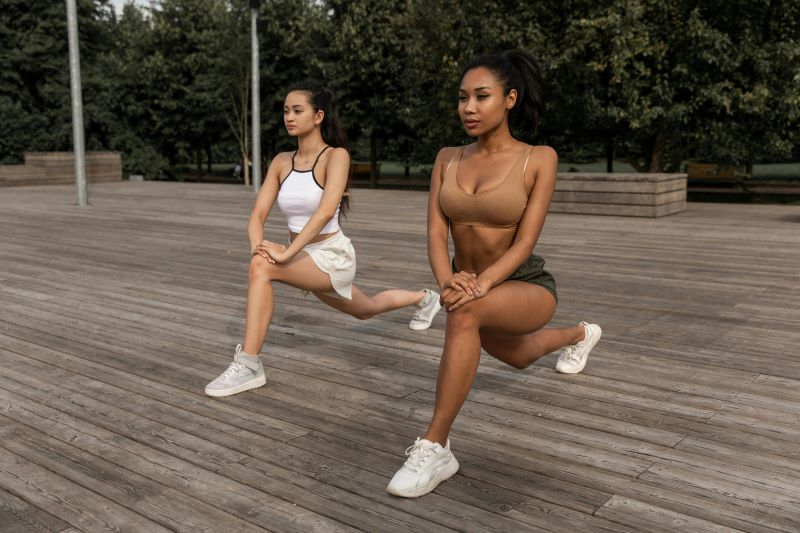
This modification helps deepen the stretch in your hip flexors and quadriceps while offering extra balance support, making it ideal for beginners. In this variation, lower your back knee to the ground from the low lunge position and extend your back leg. Place your hands on your front knee, providing additional stability.
2. Anjaneyasana Open Twist
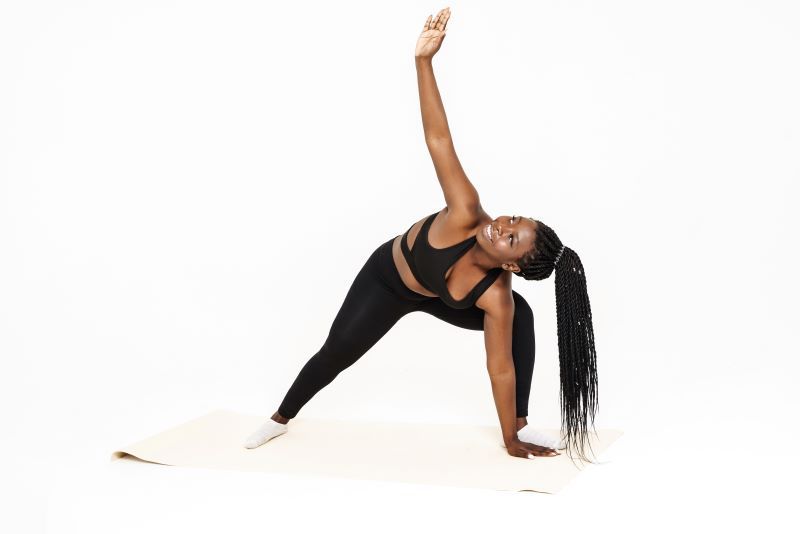
This open twist type enhances spinal flexibility, stimulates digestion, and opens up the chest and shoulders. Begin in the low lunge position with your back knee on the ground and your front knee bent at a 90-degree angle. Extend your arms out to the sides, parallel to the floor, and twist your torso towards the front leg.
3. Parivrtta Anjaneyasana
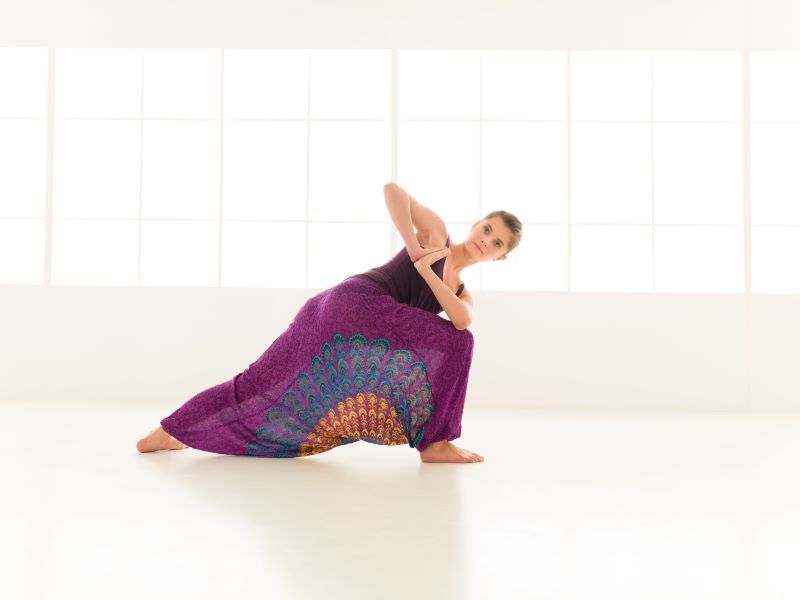
Parivrtta Anjaneyasana deepens the twist, improving spinal rotation and balance while aiding detoxification. Lower your back knee to the ground from the low lunge position and bring your palms together at your chest in Anjali Mudra. Twist your torso towards the front leg and place the opposite elbow outside the front knee.
4. Anjaneyasana Lateral Extension
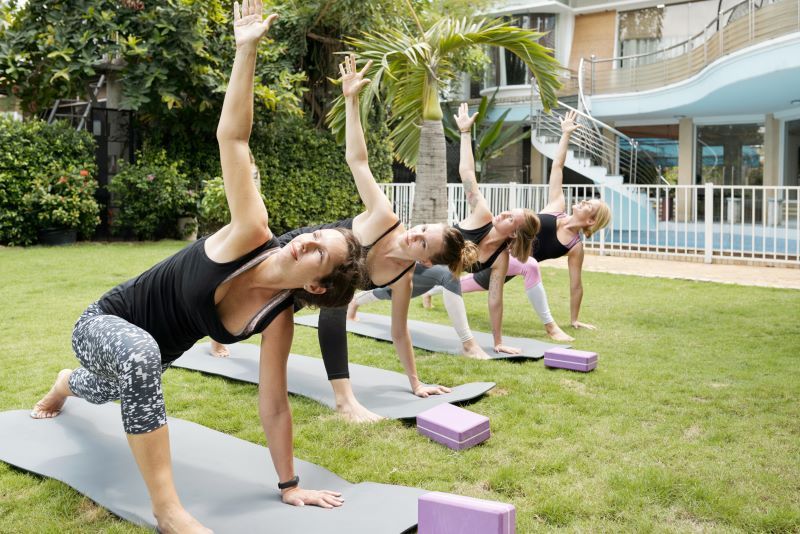
This variation targets the side body, enhancing flexibility in the obliques and intercostal muscles. Start in the low lunge with your back knee on the ground and your front knee bent. Extend your arms overhead, then lean your torso and arms to the side of your front leg, creating a lateral stretch.
5. Paschim Namaskar Anjaneyasana
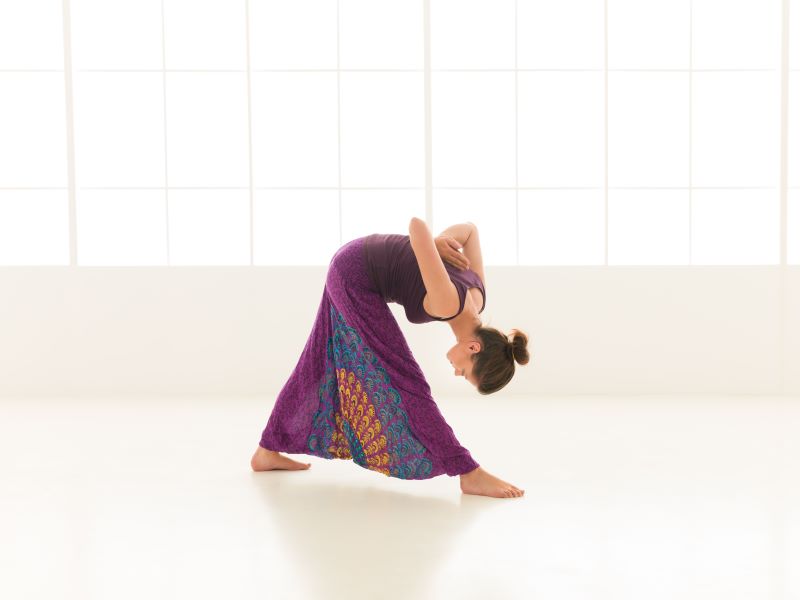
Paschim Namaskar Anjaneyasana opens the chest, stretches the shoulders, and improves posture. It also enhances flexibility in the upper back and promotes a sense of balance and calm. Lower your back knee to the ground from the low lunge position and bring your hands behind your back in the reverse prayer position.
Things to Know Before Doing Anjaneyasana
Anjaneyasana, also known as the Low Lunge Pose, is a beneficial yoga posture that can enhance flexibility, strength, and balance. To ensure a safe and effective practice, it's essential to consider the following points before you begin:
- Wear Comfortable Clothing: Opt for comfortable, stretchy clothing that allows for a full range of motion. This will help you move freely and maintain proper form.
- Create a Stable Base: Ensure your yoga mat is non-slip and placed on a stable surface. A good grip on the mat is essential for maintaining balance.
- Adjust According to Your Ability: Modify the pose to suit your current level of flexibility and strength. Place your hands on your thighs or blocks to reduce strain.
- Avoid Overstretching: It's crucial to avoid overstretching, especially if you are new to yoga. Gentle, progressive stretching is safer and more effective.
- Engage Your Core: Activating your core muscles while in Anjaneyasana helps stabilise your spine and protect your lower back.
- Mind Your Back Leg: Ensure your back leg is straight and your heel is lifted off the ground. This alignment helps appropriately stretch the hip flexors and avoid strain.
- Stay Hydrated: Drink water before and after your practice to stay hydrated. Proper hydration supports muscle function and overall well-being.
- Cool Down Properly: After performing Anjaneyasana, follow up with a gentle cool-down routine. This helps your muscles relax and prevents stiffness.
How Long to Sit in Anjaneyasana?
Anjaneyasana, or the Low Lunge Pose, is a yoga posture that benefits from being held for different durations based on your experience level. Here’s a simple guide for how long to stay in the pose:
- Beginners: If you're new to yoga, hold the pose for 4 to 8 deep breaths on each side. Focus on keeping good form and breathing deeply. As you get more comfortable, you can start holding it for longer.
- Intermediate Practitioners: If you have some experience, aim to hold the pose for 30 to 60 seconds on each side. This will give you a deeper stretch and work your muscles more.
- Advanced Practitioners: If you're very experienced, try holding the pose for 1 to 3 minutes on each side. This helps deepen the stretch, build endurance, and improve flexibility and balance.
Risks of Overdoing Anjaneyasana
Anjaneyasana, or the Low Lunge Pose, is a beneficial yoga posture that can enhance flexibility and strength. However, like any exercise, overdoing it can lead to injuries and other issues, such as:
- Muscle Strain: Holding Anjaneyasana for too long or pushing too deeply can strain your muscles. This is especially true for the hip flexors, quadriceps, and lower back.
- Joint Stress: Overdoing this pose can stress your knee and hip joints excessively. Proper alignment is crucial to prevent joint pain or injury.
- Lower Back Pain: If you arch your back too much in Anjaneyasana, you can experience lower back pain.
- Loss of Balance: Holding the pose for too long without proper stability can cause you to lose balance and potentially fall.
- Overstretching: Pushing your body too hard in this pose can cause overstretching of the muscles and ligaments, which can cause micro-tears and long-term damage.
- Fatigue: Performing Anjaneyasana excessively can lead to muscle fatigue, reducing overall performance and increasing the risk of injury.
- Aggravating Existing Injuries: If you have any pre-existing injuries, overdoing Anjaneyasana can worsen them.
Essential Tips for Practising Anjaneyasana
To practise Anjaneyasana properly, you must follow up on some tips that can help you attain a better posture, such as:
- Open Up Your Chest and Heart: Keep your heart open and your chest lifted away from the thigh. This is especially important if you have an emotional heart.
- Make Your Hip Flexible: Work on your hip mobility to achieve a better posture in low lunges.
- Keep Both Sides of the Hip at Level: Focus on whether your hip is level. Also, square off both sides of your hips towards your front and back legs equally.
What are the Precautions and Contraindications of Anjaneyasana?
There are certain conditions in which it is better to abstain from making low lunges or do it with extra care. Some are mentioned for you here:
Avoid the practice during pregnancy.
Use props while performing the asana if you have a weak balance.
Do not attempt Anjaneyasana if you have injured your back, knees, hamstrings, and hips.
Practise it only under expert guidance if you have heart disease or high blood pressure problems.
Who Should Avoid Doing Anjaneyasana?
Anjaneyasana, or the Low Lunge Pose, might not suit everyone. The following people should avoid doing this pose:
- Individuals with Severe Knee Issues: Those with severe knee pain or injuries should avoid Anjaneyasana as it can put undue pressure on the knees, potentially worsening the condition or causing discomfort.
- People with Hip Replacements: If you have had a hip replacement, this pose can stress the hip joint. It's safer to avoid Anjaneyasana to prevent complications and ensure the replacement remains intact.
- Pregnant Women in Later Trimesters: During the later stages of pregnancy, the deep stretch involved in Anjaneyasana can be uncomfortable and potentially unsafe. Modifications or alternative poses are recommended.
- Individuals with Lower Back Problems: Those suffering from chronic lower back pain or injuries should avoid this pose as the backbend can strain the lower back, potentially exacerbating pain.
- People with Balance Issues: If you have significant balance problems, Anjaneyasana might increase the risk of falls. Using props for support or choosing more stable poses can be a safer option.
- Those with Recent Abdominal Surgery: After recent abdominal surgery, this pose can strain the abdomen and slow down the healing process. It's best to avoid it until fully recovered.
- Individuals with High Blood Pressure: People with uncontrolled high blood pressure should avoid this pose, as the backbend and deep stretch can increase blood pressure levels.
- Those with Spinal Issues: If you have spinal problems such as herniated discs, Anjaneyasana can exacerbate these conditions. Consult with a healthcare professional for safer alternatives.
What are the Easy Modifications of Anjaneyasana?

The following are the easy modifications which you can adopt if you find it difficult to balance the pose:
- Use Props for Support: If it is difficult to balance the pose, you can keep yoga blocks on either side or a yoga chair in front of you. It acts as a great support to keep your hands on.
- Place a Blanket Under the Knee: In the pose, your knees are down, touching the ground, which can hurt. To protect them, you can place a yoga blanket under the knees. In contrast, you can fold your yoga mat to thicken it and avoid pain.
- Keep Your Hands on the Ground: People with conditions like high blood pressure and heart disease can feel dizzy when they lift their arms overhead. So, it is better to keep your hands down on the ground.
- Use a Yoga Strap: To deepen the back bend, you can use a yoga strap fixed at the end of your skull. Hold the belt with your hands and stretch your arms to pull it. This will lengthen your neck and lift your torso.
- Place a Wedge Under Your Front Foot: This is for people with an ankle or Achilles tendon injury. Balancing posture can be challenging, so they can use a wedge under the front foot. This lessens the stretch to the Achilles tendon and limits the intensity of dorsiflexion at the ankle.
From the above information, it is clear that Anjaneyasana has many health benefits and must thus be incorporated into your yoga regime. It keeps the ego in check and reminds people that their flexibility is fluid and can change daily. Moreover, practising Low Lunge Pose daily gives you a strong sense of balance and higher upper-body sensitivity.













